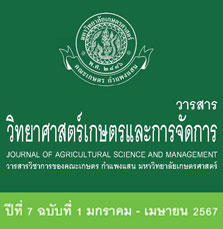Phytochemical Content Evaluation of Holy Basil Germplasm in Two Seasons and Short-Term Water Deficit
Abstract
Holy basil is a popular vegetable and it is produced all year round. There is a diversity holy of basil cultivars in Thailand and most of Thai holy basils are landraces. Holy basil cultivars were collected by the Tropical Vegetable Research Center and there has been no phytochemical evaluation. Fourteen holy basil germplasm accessions and five commercial cultivars were planted in field conditions and their phytochemical profiles were evaluated in two seasons. There were genotype by environment interactions of phytochemical traits. For holy basil in two seasons, green leaf holy basil OC-063 and red leaf OC-194 had not different in beta-carotene content and total chlorophyll. Green leaf holy basil OC-024, OC-057, OC-063, OC-195 and red leaf OC-194 were high phenolic compounds in both seasons. Moreover, phytochemicals were evaluated under short water deficit for 3, 6 and 9 days. The results showed that holy basil response to water deficit stress was independent of leaf color. Water deficit did not affect beta-carotene content in most holy basil accessions while some accessions had an increase beta-carotene and a decrease in chlorophyll a and Chlorophyll b due to a water deficit. Phenolic compounds, in most holy basil accessions decreased when they were under water deficit for 3 days but phenolic compounds increased after 9 days of water deficit
References
รัชนีกร นามบุดดี. 2564. การศึกษาลักษณะทางสัณฐานวิทยาและฤดูกาลเก็บเกี่ยวต่อปริมาณสารทุติยภูมิของกะเพรา (Ocimum sanctum L.). วิทยานิพนธ์วิทยาศาสตร์มหาบัณฑิต. มหาวิทยาลัยธรรมศาสตร์. กรุงเทพฯ. 112 หน้า.
ศูนย์ภูมิอากาศ กองพัฒนาอุตุนิยมวิทยา. 2564. สภาวะอากาศของประเทศไทย พ.ศ.2563. (ระบบออนไลน์). แหล่งข้อมูล: http://climate.tmd.go.th/content/file/2031 (13 มิถุนายน 2565).
Alishah, H.M., R. Heidari, A. Hassani and A.A. Dizaji. 2006. Effect of water stress on some morphological and biochemical characteristics of purple basil (Ocimum basilicum). Journal of Biological Sciences 6: 763-767.
Barickman, T.C., O.J. Olorunwa, A. Sehgal, C.H. Walne, K.R. Reddy and W. Gao. 2021. Yield, physiological performance, and phytochemistry of basil (Ocimum basilicum L.) under temperature stress and elevated CO2 concentrations. Plants (Basel) 10(6): 1072.
DOAE. 2016. Holy Basil in 2016. (Online): Available Source: https://production.doae.go.th (July 21, 2021).
DOAE. 2017. Holy Basil in 2017. (Online): Available Source: https://production.doae.go.th (July 21, 2021).
DOAE. 2019. Holy Basil in 2019. (Online): Available Source: https://production.doae.go.th (July 21, 2021).
Hakkim, F.L., C.G. Shankar and S. Girija. 2007. Chemical composition and antioxidant property of holy basil (Ocimum sanctum L.) leaves, stems, and inflorescence and their in vitro callus cultures. Journal of Agricultural and Food Chemistry 55(22): 9109-9117.
Huqail, A.A., R.M.E. Dakak, M.N. Sanad, R.H. Badr, M.M. Ibrahim, D. Soliman, and F. Khan. 2020. Effects of climate temperature and water stress on plant growth and accumulation of antioxidant compounds in sweet basil (Ocimum basilicum L.) leafy vegetable. Hindawi Scientifica 2020: 12.
Iakovos, K., M. Menexes,P.E. Georgiou and C. Dordas. 2020. Effect of water stress on the physiological characteristics of five basil (Ocimum basilicum L.) cultivars. Agronomy 10(7): 1029.
Keawsaard, S. 2012. Ocimum sanctum Linn. and free radical scavenging activity. Journal of Science Ladkrabang 21(2): 54-65.
Malumpong, C. 2019. Principles of Plant Breeding. Bangkok: Kasetsart University Press. 342 p.
Mondal, S., B.R. Mirdha and S.C. Mahapatra. 2009. The science behind sacredness of tulsi (Ocimum sanctum Linn.). Indian Journal of Physiology and Pharmacology 53: 291-306.
Muhammad, M.K., A.H. Muhammad, and S.A. Alfie. 2012. Variations in basil antioxidant contents in relation to deficit irrigation. Journal of Medicinal Plants Research 6(11): 2220-2223.
Nagata, M., and I. Yamashita. 1992. Simple method for simultaneous determination of chlorophyll and carotenoids in tomato fruit. Nippon Shokuhin Kogyo Gakkaishi 39(10): 925-928.
Nambuddee, R., P. Rithichai and Y. Jirakiattikul. 2020. Morphological characterization and grouping of holy basil (Ocimum sanctum L.). In: The 18th National Horticultural Congress. doi: 10.14457/KU.res.2020.14 p.6
Sarker, U. and S. Oba. 2018. Drought stress enhances nutritional and bioactive compounds, phenolic acids and antioxidant capacity of Amaranthus leafy vegetable. BMC Plant Biology 18: 258. https://doi.org/10.1186/s12870-018-1484-1
Srikachar, S., K. Damra, A. Siriudom, N. Satyasai, S. Chaulit and P. Kanchanakesorn. 2017. Combined pest control technology in holy basil/sweet basil. (Online): Available Source: https://www.doa.go.th/research/attachment.php?aid=2652 (July 21, 2021).
Thaipong, K., U. Boonprakob, L. Cisneros-Zevallos and D.H. Byrne. 2005. Hydrophilic and lipophilic antioxidant activities of guava fruits. Southeast Asian Journal of Tropical Medicine and Public Health 36(4): 254-257.
Wangcharoen, W. and W. Morasuk. 2007. Antioxidant capacity and phenolic content of holy basil. Songklanakarin Journal of Science and Technology 29(5): 1407-1415.





